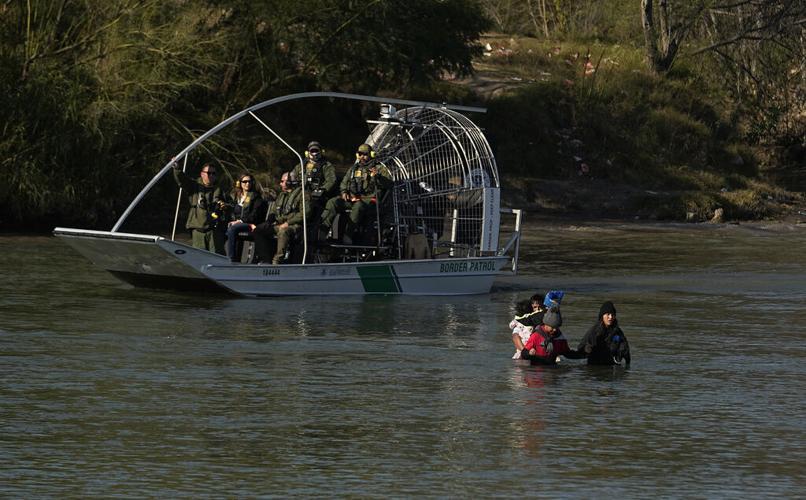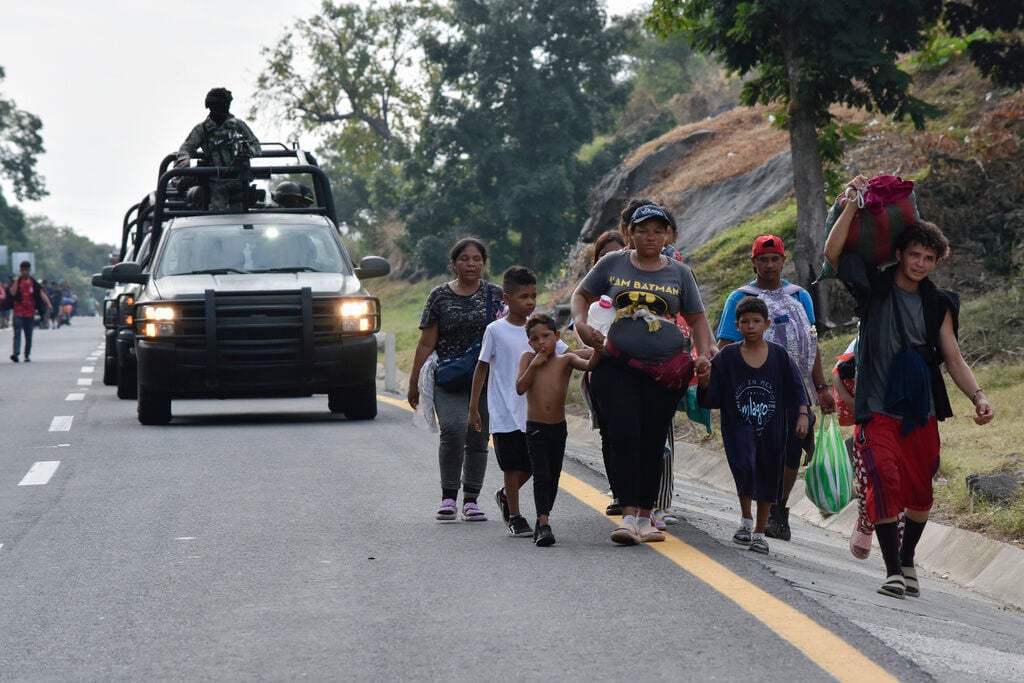After meeting with top U.S. officials, and after enduring the economic pain of multiple shuttered U.S. ports of entry, Mexico's leadership has agreed to take action to slow the high volume of migrant arrivals at the U.S. border.
But early reports suggest some of those enforcement actions are leading to family separations and the arbitrary transport of migrants away from the U.S. border, without any official processing, as well as to increased reports of abuse by Mexican authorities and criminal organizations, aid workers and advocates say.

Mexican President Andrés Manuel López Obrador, center, meets with U.S. Secretary of State Antony Blinken, top left, partially covered, and other officials in Mexico City on Dec. 27, 2023.
At the Kino Border Initiative's migrant-aid shelter in Nogales, Sonora, staffers are already noting a surge in abuse reports during intake interviews with migrants. Migrants report Mexican authorities using the threat of deportation and intimidation tactics to extract payments.
In the first four days of January, asylum seekers who arrived at Kino's shelter reported 27 instances of abuse, primarily extortion or robbery at the hands of Mexican immigration officials or law enforcement, said Joanna Williams, executive director of the binational, Catholic-led nonprofit that offers food, shelter, legal assistance, psychological support and other services to migrants on the border.
In all of December, Kino received 26 reports of abuse by Mexican immigration officials and 60 reports of abuse by Mexican law enforcement. The latter figure is twice what was reported in November, she said.
So far in January, “we’re on pace to far outstrip what we saw in December,” Williams said. “That’s striking to me. It’s outside the norm.”
Mexico's stepped-up enforcement efforts are making humanitarian aid workers fear for the safety of migrants traveling the country or waiting south of the U.S. border for asylum appointments.
If the U.S. is going to lean on Mexico to better manage migration, advocates say the United States should also step up its support for Mexico's shelters and humanitarian resources, so migrants can remain safe while waiting there.
The shelter system has long been strained in Mexico. Some shelters have shut their doors after criminal groups started pressuring staffers to extort money from migrants waiting for U.S. asylum appointments, said Ari Sawyer, the Mexico City-based U.S. border researcher for advocacy group Human Rights Watch.
Across the border from Laredo, Texas, in Mexico, "shelter workers told me the cartel would walk into the shelter and say, 'Give us the money, and all the information for everyone staying here,'" Sawyer said. "They would just turn it over because they had no other choice. They decided it would be better to shut down."
Few public details
U.S. officials reopened four ports of entry along the southern border on Jan. 4, including at Lukeville, Arizona, about a week after a meeting between Secretary of State Antony Blinken, other top U.S. officials and Mexican president Andrés Manuel López Obrador. A joint news release that came out of the meeting emphasized both countries' commitment to "orderly, humane and regular migration."
U.S. officials have attributed a recent dip in migrant arrival at the southern border to both Mexico's enforcement efforts and the expected lull in migration often seen during the holidays.
Mexico and the U.S. haven't publicly released details of Mexico's plans to deal with migration, which is likely a strategic move, said Ariel Ruiz Soto, senior policy analyst for the Migration Policy Institute. Less detail makes it harder to measure results from those efforts, he said.
Mexico's recent enforcement efforts have been focused on cracking down on smugglers who transport migrants by train or bus through the country. Before meeting with U.S. officials, Mexican leadership also announced a resumption of deportation flights for migrants from Venezuela.
Experts say many of the strategies Mexico is implementing now will only result in temporary dips in migration, and can put migrants in danger.
NPR reported on Jan. 5 that Mexico's successful effort to disperse a migrant caravan of 4,000 last week was rooted in deception: Authorities told migrants they would bus them to processing centers, but instead migrants were dropped off in various cities throughout the south of Mexico, often without any way to reconnect with family from whom they were separated.
Human Rights First will be investigating instances of arbitrary transport of migrants to determine whether migrants' rights have been violated, said Christina Asencio, the Tucson-based director of research and analysis for refugee protection with Human Rights First.
"In light of these actions, absolutely there are concerns that this can escalate to further rights violations and risk of harm to these individuals," she said.
Transporting migrants away from the U.S. border may reduce migration for a few weeks or months, but large-scale systemic changes in U.S. policies — such as investing in the U.S. asylum system — will be necessary for lasting change, Ruiz Soto said.
"There are things Mexico can do more of, but they’re not going to lead to significant results in decreasing migration," he said.
Dangers in waiting
Other new enforcement efforts in Mexico have resulted in chaos and peril for migrants, Asencio said.
Last week, Mexican officials dismantled a large migrant camp in Matamoros, across the border from Brownsville, Texas, and in the aftermath, migrants reported family separations, as some were transported by air to southern Mexico, Asencio said.

A member of the U.S. Border Patrol talks with migrants gathering along the border in Lukeville, Ariz., including a family from Zacatecas, Mexico, in December.
Migrant families have also been experiencing family separations while traveling through Sonora.
At Casa de la Misericordia, a migrant-aid shelter in Nogales, Sonora, a mother originally from China, traveling with her two children, reported that her husband was detained by Mexican authorities in Hermosillo and bused to Central Mexico. The mother and kids are currently waiting at the shelter, hoping to find out how to reunite with him, said shelter director Alma Angélica Macías Mejía.
Asylum seekers at Kino Border Initiative's shelter are now waiting up to six months to secure an appointment to request asylum through the CBP One app, promoted by the Biden administration as the only legitimate way for most migrants to request asylum. It's been criticized for its shortage of appointments in the face of enormous demand, compelling migrants to wait for months in dangerous conditions south of the border.
In June, the U.S. government halted CBP One app appointments at the Laredo port of entry, after aid workers reported migrants waiting across the border, in Nuevo Laredo, were being targeted for extortion, the Associated Press reported. Asylum-seekers said Mexican officials threatened to make them miss their CBP One appointments unless they paid them.
Immigrant rights groups are challenging the legality of the Biden administration's so-called "asylum ban," which punishes those who request asylum outside the app.

U.S. Border Patrol agents watch as migrants cross the Rio Grande at the Texas-Mexico border on Jan. 3, in Eagle Pass, Texas.
Casa de la Misericordia's shelter in Nogales, Sonora has a capacity of about 120 people and it's always full, as migrants wait five months or more for CBP One app appointments, Macías Mejía said.
Migrant-abuse reports are also common here, she said. A group of arrivals from Colombia said they were sexually assaulted by Mexican police. Others report "false checkpoints" manned by criminals posing as law enforcement, where migrants are forced to disembark from buses and hand over money, often with the knowledge of local authorities, she said.
"I call it 'authorized crime,'" Macías Mejía said in Spanish. "There is no authority that prohibits or prevents it."
Kidnapping and extortion of migrants has become part of criminal groups' lucrative businesses, advocates say.
On Jan. 3, about 70 miles south of Nogales, Arizona, 18 kidnapped migrants were rescued from the Motel Apolo in Santa Ana, Sonora, according to a statement from Sonora's Attorney General's Office.
Federal and state authorities rescued the victims, who hailed from Ecuador, El Salvador, Guatemala, India, Ethiopia and Brazil, the statement said. Armed men had taken some of the victims from a passenger bus and others from a restaurant, the victims reported.
Criminal groups often target migrants for kidnapping because many have relatives in the U.S. with resources, advocates say.
"They know the majority of these folks have friends or family in the U.S.," Sawyer said. "It's systematized. They kidnap them, scroll through their phone looking for U.S. numbers and call them," demanding a ransom.
Major challenges facing Mexico
Mexico faces major hurdles in controlling migration, Ruiz Soto said. The country faces similar challenges as the U.S. does, but with fewer resources and less technology, he said.
During the Obama administration Mexico relied a lot on immigration checkpoints on major transit routes to intercept migrants’ travel, and in recent years has shifted more enforcement work to the National Guard, he said.
Mexico’s migrant-detention capacity is low, less than 10,000 nationwide, Ruiz Soto said.
And the country's southern border with Guatemala is even harder to manage than the U.S.’s southern border, he said. The border with Guatemala is part jungle and contains rivers that make it difficult to build enforcement infrastructure there.
“I think Mexico and the U.S. government understand that, so that’s why the focus is not so much stopping migrants at the Guatemala border, but in trying to reduce the flow once migrants are in Mexico,” he said.
Deterrence efforts, such as limiting foreigners' access to buses and trains through Mexico, can end up pushing migrants into the arms of human smugglers, who are often “one step ahead of the game,” Ruiz Soto said.
"The other factor here is smugglers who are very well aware how to adapt to those (enforcement) changes," he said.
Restrictions on access to the U.S. asylum system further enriches criminal gangs in Mexico, who profit when legitimate avenues to immigrate are out of reach, advocates say.
Long-term approach needed
Immigration experts say a long-term approach involving multiple countries would help address migration challenges, as would improvements to the U.S. asylum system so that credible and non-credible petitions can be more quickly dealt with. Currently, border agents are releasing migrants into the U.S., after they've been processed as legal asylum seekers, with asylum-hearing dates five years away.
Mexico's president, López Obrador, has also asked the U.S. to help reduce poverty and violence in countries where migrants originate, “but the results are going to take years to be fruitful,” Ruiz Soto said.
These types of solutions, with the potential for long-term impact, aren't appealing for politicians looking for the optics of an immediate impact, Ruiz Soto said.
"They tend to not be politically viable because politicians in Mexico and the United States want an answer today — not tomorrow, not two years from now, not under the next president," he said. "They want border enforcement now. As long as that continues to be the target, it will suffer from the same limitations of capacity that exist today."
Globally, 100 million people are currently displaced, compared to 60 million in 2014, according to the United Nations High Commissioner for Refugees.
Advocates say conversations about U.S. immigration often start with the premise that migrants "shouldn't" be at the border. Acknowledging the reality that they are there, and that under current law, people have the right to request asylum on U.S. soil, is a starting point for constructive debate, said Sawyer of Human Rights Watch.
"Human beings have been migrating for all of our existence," Sawyer said. "Migration is a fundamental fact of our existence. It's never going to stop, whether people are fleeing conflict or starvation, or just looking for adventure or a new life or to be with family. Once we accept that as a country, and also other countries in Europe (do), we can start making better choices about how we deal with that."
Get your morning recap of today's local news and read the full stories here: tucne.ws/morning








